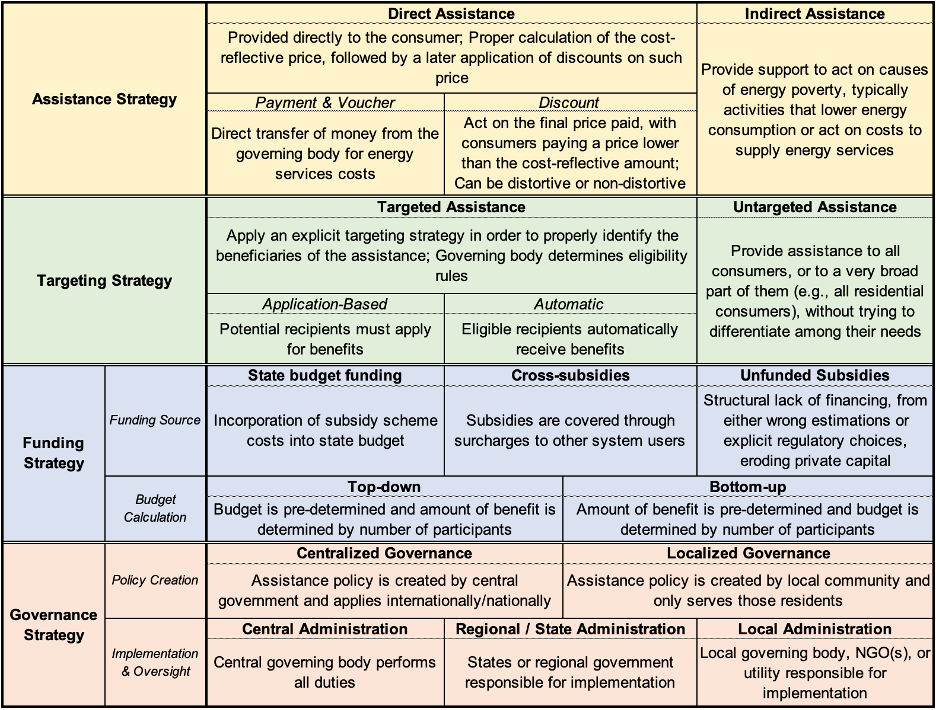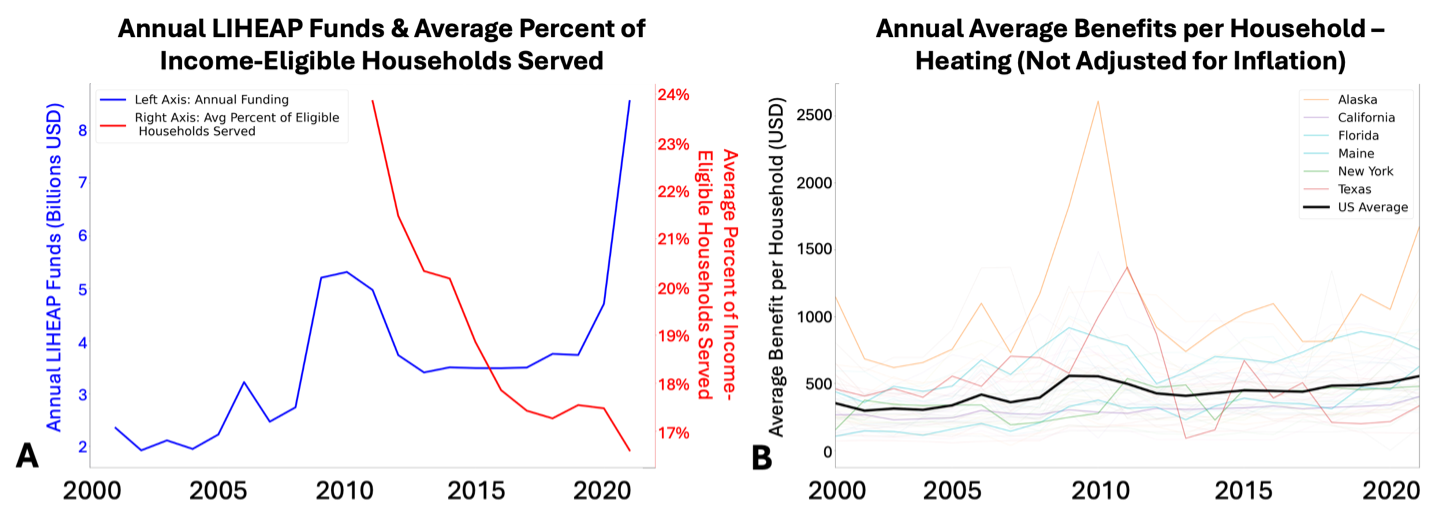CEEPR Working Paper
2024-07, June 2024
Peter Heller, Tim Schittekatte, and Carlos Batlle
As climate change continues to worsen and cause more extreme temperature fluctuations and weather events, access to sufficient energy services will be increasingly vital. Despite their essential role in the energy transition, low-income households are likely to experience the most significant impacts of these changes. Without the necessary financial support, they will unavoidably struggle to have access sufficient (affordable) energy to maintain adequate living conditions. The goal of this paper is to review how governments currently design strategies to reduce the overall number of households living in energy poverty in order to extract lessons on how to best deliver assistance.
Energy poverty, in the context of this paper, describes the inability of a household to adequately utilize sufficient amounts of electricity, heat, and other energy services due to financial constraints. It is driven by three main factors: sustained low incomes, high energy services costs, and poor dwelling energy efficiency. In the European Union (EU), approximately eight percent of households report being unable to keep their dwellings adequately warm. Nearly 10 percent of households in the United States (US) also keep their homes at unhealthy or unsafe temperatures, according to the 2020 Residential Energy Consumption Survey (RECS). In the same year, approximately 20 percent of households report having reduced or not purchased basic necessities in order to pay their energy bills.
In order to review and compare approaches to address energy poverty policy in both the EU and US contexts, we build a framework that includes four key categories of strategical decisions. These categories can be framed around four key questions:
Assistance: What type of help should be employed?
Targeting: Who should be targeted and by what criteria?
Funding: Where are funds obtained to implement the policy?
Governance: Who is responsible for implementation and oversight?
A summary of the four dimensions of energy poverty policy design discussed are presented Table 1. For the derivation of these dimensions and information on relevant policies that can be classified into each one, please see the full working paper.

Table 1. Summary of Dimensions for Energy Poverty Policy Design.
A majority of the energy poverty policies implemented in the US and EU utilize direct assistance. These types of programs are important to provide immediate relief to households to ensure the lights stay on and that indoor temperatures remain healthy. Additionally, these policies are effective in the near term and can alleviate pressure on the governments to take action to help households. These policies work particularly well when there is an energy crisis and spikes in energy services costs are realized, but they can be seen as treating energy poverty as a temporary experience for households. In reality, there are many households that experience energy poverty consistently from year to year. This distinction between temporary and permanent energy poverty is important when considering the type of assistance strategy to employ. Indirect policies that address energy efficiency or provide access to distributed energy resources can serve to help address part of the underlying issues that pushes households into energy poverty (recall the three main drivers of energy poverty: sustained low incomes, high energy services costs, and poor dwelling energy efficiency). By working to fix the causes of energy poverty through indirect support policies, governments can begin to lift households out of energy poverty and reduce their reliance on direct support programs.
Regardless of the assistance strategy selected, the next step requires determination of which households will be eligible for the program. For energy poverty policies specifically, the criteria for targeting act as a quasi-definition for energy poverty; however, many targeted policies use only income data or social welfare status, which blurs the line between energy poverty and general poverty experiences. While households that experience energy poverty typically overlap with households that are living in poverty, as defined by the government, they are not always the same. There are households in which their income puts them above the poverty threshold, but their energy services costs either put them below the poverty line or they are forced to forgo the purchase of necessary goods to pay their energy bills. As a result, when thresholds are derived for governmental support, it is important to be cognizant of wrongful exclusion and wrongful inclusion in which numerical cutoffs force differentiation among individuals that should or should not be considered the same. Among the policies instituted in the EU to shield households from the energy crisis beginning in 2021, approximately 78% of all allocated and earmarked funding across member states was used for untargeted programs that acted on prices or supplemented incomes. This is purposeful wrongful inclusion as all households and businesses were affected greatly by the energy price shocks that occurred during the crisis.
In the long term, though, it is important to target these programs to households that need it most. If the only criteria to qualify for the program is energy burden, it is likely that some households experiencing energy poverty will be wrongfully excluded as they have an income above the threshold but high energy services costs or have purposefully reduced their consumption to unhealthy levels to lower their energy burden. On the other hand, some households could be wrongfully included if they have a moderate to high income but utilize large amounts of energy (e.g., for electric vehicle charging, private swimming pool heating, etc.) that push their energy burden to be above the threshold. In practice, though, obtaining data beyond income, energy burden, and demographic data can be challenging at the regional or national scale. As a result, many government programs must rely on a select few characteristics to qualify households that may lead to these inclusion and exclusion problems.
Beyond the eligibility criteria selection, we note a strong connection between the funding mechanism selected and the usage of an application versus automatic qualification. Policies that employ a top-down approach typically require applications from households to certify household eligibility. On the other hand, there is a clear parallel with the automatic qualification based on eligibility and the usage of the bottom-up approach. By estimating the budget based on the number of eligible households, the program is designed to provide benefit to all that qualify so automatic qualification works well. There are some cases of policies designed with the bottom-up approach that use an application system to certify eligibility; however, it is expected that all households that are able to prove eligibility will receive the benefit. In the top-down approach with applications, it is not guaranteed that all households will receive the benefit, as applications need to be reviewed and households selected for qualification to not erode the benefit to a non-useful amount. Figure 1 illustrates this phenomenon with data published by the US Department of Health and Human Services. Despite the increasing LIHEAP budget, the percent of income-eligible households receiving assistance is decreasing while the average amount of heating benefit remains constant.

Figure 1. US LIHEAP Budget, Income-eligible Households Served, and Average Annual Heating Benefit.
The nominal value of heating benefit remains nearly constant; however, the percent of eligible households being helped is decreases over the period despite budget increases. This is a feature of the top-down approach that sets the budget first and then divides up the resources. This suggests that the number of federally eligible households is increasing at a faster rate than the budget for the program is increasing, and the top-down budget design is continuing to limit the number of eligible households that are receiving any assistance.
As a result of how the application process is designed in the US, there are only a limited number of eligible households that actually benefit from these programs. Despite the means testing approach successfully helping the households with the most need, with lowest income decided as the proxy, the LIHEAP and WAP programs in the US fail to help even more than one in four households that are eligible. Therefore, there is a decision to be made within the application design. If the application is solely to confirm household data that the governing body may not have readily available, it can still reach all of the eligible households. When decisions are made based on the application and automatic qualification is not made as a result of successfully submitting the application, families that deserve the assistance may not receive it. Additionally, an issue with any application-based program design is ensuring that all households have knowledge of the program and the resources to apply. Many families, often those who may need assistance the most, are unaware of a program’s existence and lack the necessary information on how to enroll in them successfully. Lengthy applications and any required trips to government offices—only open during regular business hours—make these applications especially tough for low-income and rural families. When these programs rely on a household’s knowledge of and access to program applications, they risk excluding households that require these benefits to maintain healthy, sustainable living conditions.
This analysis highlights the complex and multifaceted approaches taken by the US and EU to combat energy poverty. Through this review and classification of various policies and programs by assistance, targeting, funding, and governance strategies, we extract key challenges that governments face when designing them. While direct assistance programs provide crucial immediate relief, increasing emphasis on energy efficiency and affordability of distributed energy resources is needed to address the underlying causes of energy poverty. Balancing immediate support with long-term sustainable solutions is difficult both financially and politically; however, we have seen a shift towards this balance in recent years. The effectiveness of any of these strategies requires ongoing evaluation and adaption to ensure that they meet the evolving needs of the energy poor. Comprehensive data collection and access to utility data is necessary to improve the targeting of households and the ability of administering agencies to engage with them. Additionally, increased coordination among federal governments, local governments, and NGOs will combine the large-scale budgets and power of centralized governments with the local knowledge of lived experiences to better serve affected communities.
As climate change intensifies and wealth inequality increases, low-income households will face the greatest burdens of the energy transition despite being essential to the transition’s success. Future policies should prioritize comprehensive strategies that integrate direct assistance with investments in sustainable energy infrastructure, fostering collaboration across sectors to innovate and implement solutions that not only alleviate energy poverty but also contribute to global environmental goals.





